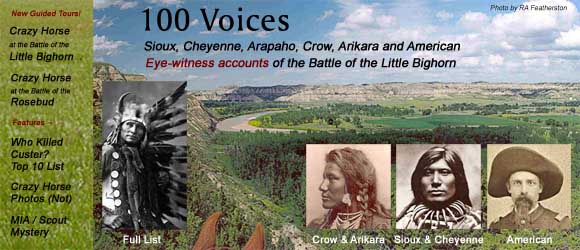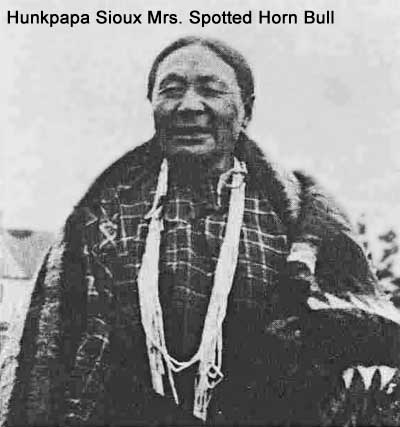Bruce Brown's 100 Voices... Mr. and Mrs. Spotted Horn Bull's
MR. AND MRS. SPOTTED-HORN-BULL RELATE THE STORY OF RENO'S RETREAT AND CUSTER'S CALAMITY SUCCINCT AND CREDIBLE ACCOUNT OF THE DAYS PRECEDING THE FATAL TWENTY-FIFTH OF JUNE HOW THEY DIED AND WHERE -- HE SAVED HIS LAST SHOT -- A SQUAW'S DIAGRAM.
The Scene and the Story In the comfortable parlor of Maj. McLaughlin's agency residence, not many nights ago, the hour nearly midnight, and the air outside cold as the glance of a hostile's eye, sat the Major and his wife, Mr. and Mrs. Spotted-horn Bull and the Pioneer Press correspondent. Maj. McLaughlin had already heard in part the story which the Indians had to tell; but the recountal, after adroit questioning, was given in full -- Mrs. McLaughlin, whose knowledge of Sioux is perfect, interpreting. The woman did nearly all the talking, and her husband-a swarthy Uncpapa, of powerful frame and a reputation for bravery second to none-was evidently proud of his wife's intelligence and ability as a raconteur. The wife, dressed in clean and bright colored calico, with the usual broad leather belt thickly studded with brass nails, encircling what was left her of waist, with bright copper complexion, brighter eyes, twinkling now and then with mirth, but gleaming sometimes with the ferocity which makes the roused Sioux squaw a terror to her own camp, with glistening rows of perfect teeth -- rare in an Indian woman over thirty -- was a rather pleasing picture. The Major (all Indian agents have the title by courtesy and custom) prefaced the talk by saying that the woman is the full cousin of Sitting Bull and one of the best known individuals in her nation. Only a few days before she had soundly whipped the redoubtable Gall, and prevented him from throwing away one wife, a relative of her own, and taking another. It turned out later that her story of the Little Bighorn had been often told, and Sitting Bull, in whose regard she held, and holds, high place, had nodded many an assent to her related remembrances. It is impossible to describe how animatedly the woman spoke. Her gestures were constant and varied, and such a reader of signs as Philo Clark of Sheridan's staff could almost have translated her story from her fingers. But to the dual tale, thus syllabized: |
|||||||||
Sitting Bull Makes Medicine Eleven days before the Custer fight the Sioux were encamped some distance from the Little Bighorn (known to them as the Greasy Grass) and a solemn sun dance was held, traces of which were afterwards seen by the troops. Though long ago absolved from partaking of its pains and penalties, Sitting Bull, the medicine man and counsellor more than the warrior, was one of those tied to the pole of suffering, and the pierced muscles of his breast still show the scars of that dire observance. One by one the others broke their bonds or succumbed to pain and fasting, but he-not trying especially to tear awayseemed rapt in study. Two days and two nights went by without a morsel of food or a drop of water passing his lips, and on the morning of the third day he fainted. During his trance his faithful squaws and friends-among them the narrator- forced food and drink between his lips, and when he revived, and strength returned, he told, most solemnly, of a dream in which it had been foreshadowed to him that his people were soon to meet Custer and his followers, and would annihilate them. Two mornings after this revelation, and seven before the Custer fight, just as dawn was breaking, a large force of Crows attacked the Sioux, and all day long the battle lasted. The fight could not have been a very hot one, since only seven of the Sioux were slain and the Crows succeeded in carrying away all but one of their dead when, beaten and discomfited, as they were toward evening, they retreated into the heights of the Wolf mountains. The Sioux were not particularly proud of their victory, which they considered as dearly bought, and, though Mrs. Tatanka said the Crows numbered thousands, her husband grunted a stomachic dissent. The next morning the Sioux encampment was broken and moved to the fertile valley of the Little Bighorn, to the spot now historic, about fourteen miles south of the present Fort Custer (located at the junction of the Bighorn and the Little Bighorn rivers) and as nearly as the speaker could recollect, about thirty miles from the scene of the Crow fight. The Plan of the Hostile Camp The bodies of the seven Sioux had been brought to the new encampment on travoix and were placed in a tepee on the extreme right, or south, of the town of tepees, which soon spread for nearly five miles along the river, and on its western bank. The correspondent had visited the battlefield in August, 1882, and was familiar with the lay of the land and the salient points of the locality. To test the accuracy of Mrs. Tatanka's memory, she was plied with questions, every one of which she answered readily, and finally, drawing herself up with dignity, said: "Why shouldn't I know the place? It is a part of my country." Like most of the Sioux she possesses deftness in delineating, and taking a visiting card and pencil, and with occasional references to her husband, she drew the appended diagram, saying, as she did so, it would serve to make her story clear, and supplementing it later with a rough sketch of all the streams in the surrounding country, from the Missouri on the north to the Little Missouri on the east. Explanations of the Ground Asked as to the number of warriors the seven tribes mentioned mustered at the time, the narrator was unable to give a definite estimate, but her husband after a lengthy and -- to a white man --abstruse calculation, said 5,000 would cover the braves and chiefs. This number is probably correct or nearly so, as it agrees with computations of the best posted scouts who saw the encampment before and after the fight. As the diagram shows, the river runs nearly north at the scene of the fight. The ground on the west bank, where the Indians were camped, is level, and the five tribes on the north were on the flat near the river, the other two being on the first bencha rise of from four to six feet-while above them to the west and south the plain extends. On the east side of the river, where the troops approached, the hills are precipitous and at G, where Reno threw up his shallow earthworks, the height above the river-here an easily fordable stream so far as depth is concerned-an altitude of at least 200 feet is attained. The point K, is the extremity of the highest ground, and to its peak Capts. Benteen and Weir rode before joining Reno, but could see nothing of Custer. The spot where Reno crossed on his retreat is marked as R and on the plain leading thereto, marked M, Lieutenant McIntosh was pulled from 'his horse and killed, while Hodgson lost his life in the ford. The descent into the river from the side on which were the Indians, is over a bank only a few feet in sheer height, but on the bluff side the shore rises at an angle of more than 45 degrees. Only thoroughly panic-stricken troops could have scaled such an acclivity, and the reason all were not killed is explained by Mrs. Tatanka later, when she tells of the counter panic among the reds. The ride up the hills to the breast works is steep, but not markedly so, and the retreating troops made it in good time for tired horses. The lower line is intended to indicate the first bench. Riverward, below it, is a moderately dense chapparal of willows and cottonwoods. On the plain above, trees are few. Where Custer fell, H, the ground is high and treeless but rolling, and the descent to the river is not as steep as farther south. The line marked I indicates a coolie in which in June water runs, but later in the year it is perfectly dry. June Twenty-fifth The Indian woman continued her account, after drawing the diagram and explaining the positions of the various camps, by saying that very early in the morning of the day of the fight (June 25) seven Cheyennes started southeast to join Spotted Tail. Five of them, it would seem, got through all right, but early in the morning two rode to the brow of the bluffs and signaled with their blankets that white troops in large numbers were advancing rapidly. The troops seen by the scouts were Custer's, for immediately after the signalling, and while the camp was in commotion, Reno's command came up, unseen by most of the Indians, from the south and on the western side of the river, and opened fire. The white men were dismounted and the narrator told how one man was left behind to take care of four horses, as is the custom in dismounted fighting on the frontier. The camp, as said, was in the wildest commotion and women and children shrieked with terror. More than half the men were absent after the pony herd. The story teller waxed excited as she said: "The man who led those troops [Major Reno] must have been drunk or crazy. He had the camp at his mercy, and could have killed us all or driven us away naked on the prairie. I don't believe there was a shot fired when his men commenced to retreat. (Her husband qualified this by saying, "Not much firing by the Indians.") But when they began to run away they ran very fast, and dropped their guns and ammunition. Our braves were not surprised by this time, and killed a good many when they crossed the plain to the river, while they were fording and on the hill beyond. I saw boys pull men from their horses and kill them on the ground." Several times over this Sioux Scheherazade repeated her disgust at the action of the whites and the only explanation she could give for the retreat was that Reno saw, when he got into it, how large the Indian village was and was seized with a panic greater than that among the Indians themselves. That the latter was very decided, however, was proven by the fact that the warriors hurriedly returning with the quickly rounded herds, met many fugitives from the camp and feared the worst on their own return. Custer Comes Up The Reno retreat and its consequent slaughter was scarcely ended before the blare of Custer's trumpets told the Sioux of his approach. But they were prepared for him, The men quickly crossed the river, and by hundreds galloped to his rear, out of range at first, but taking advantage of coolie and mound, soon hemming him in constantly narrowing circles. Mrs. Tatanka mounted her pony and rode to the first bench behind her camp, where she could get a good view of the hills beyond. She saw the troops come up, dismount, each fourth man 'seize the bridles of three horses beside his own, the rest deploy and advance on the run toward the river. She saw the terrible effect of the withering fire which greeted the approach from the willows on the Indian side of the stream, and laughed as she said: "Our people, boys and all, had plenty of guns and ammunition to kill the new soldiers. Those who ran away left them behind." Slowly trotting north, along the outskirts of the encampment, she noted the Indians who had crossed, getting closer to the troops. She watched the latter -- those who were left of them --retreat to their horses and mount; she heard the yells of her kindred and the shouts of the whites; but soon, as the former grew plentier and the latter fewer, she could distinguish little, save here and there an animated cluster of men and horses. Slowly her pony jogged down the stream, and she reached the Minneconjou camp on the extreme left-not an hour's ride-she said not one white soldier was visible on the field. Of horses there were plenty. These the Indians spared, of course. Tatanka himself, describing the animals, said they were fat and good looking, but (making a slow motion up and down with both hands) could only canter slowly, while the Indian ponies, "like birds," flitted in and through and about the troopers' broken lines. Less than fifty minutes and more than five lives to the minute! He Might Have Lived From the husband was learned one incident of the day. One man, he thought an officer, was the last to live. He was mounted on a splendid horse (the color was forgotten), and seeing all his comrades dead, started up the ravine marked I in the diagram. Two Ogalallas, two Uncpapas and a Brule, all well mounted, started after him. He gained on them all, and one by one dropped off until the Uncpapa, who was unarmed, as it turned out, alone pursued [Note: Flying Hawk identifies the soldier's last pursuer as Crazy Horse]. The latter was about to give up the chase, when the soldier turned, saw his pursuer, noted that his own horse was flagging, drew a revolver from the holster at his hip and blew his own brains out. "He had a good horse," concluded Tatanka, "and the Sioux (mentioning his Indian name) rode him for years after that." The Sioux thought the distance ridden by pursuer and pursued was about seven miles from the battlefield, but it might have been more. Lieut. Harrington's body was never found, or at least never recognized, and this sad suicide might have been he. After the Battle Custer and his command killed, the Sioux again turned their attention to the troops on the hill [Reno and Benteen's troops] and the woman, resuming the story, laughed gleefully as she told what fun the bucks had shooting at the soldiers as they ran that terrible gauntlet, down the hill to the river, for water [Note: see George Herendeen's description of the the water detail.] The Custer men were soon stripped, of course, and the only way the Indians knew they had killed the Long-Haired Chief was by his buckskin coat trimmed with beaver, which they found on his person. The Sioux lost thirty killed and more than twice as many wounded. Among the killed were boys of twelve and fourteen, who, in the ardor of young warriorhood, rushed across the river on their ponies and into the thickest of the fight. She mentioned two boys who were wounded; one, a young Achilles, in the heel, and another in the right arm, which was shot off. Both recovered and neither of them are yet twenty, though seven years have passed since they counted their first coups. It was with a tone of most noticeable regret that the woman told of the quantities of bank notes found and wasted, being utterly ignorant of the value of the, to them, curiously painted parallelograms of green paper. She naively said: "We know better about them now, and wouldn't lose them as we did at that time." Of course, feasting and laudation was the order of the day and night succeeding the slaughter, but the news of Terry's approach with his command compelled a hasty breaking up of the camp. She says they marched day and night for several days, and soon the whole band was safe in the fastnesses of the Bighorn mountains, where they remained some time before a separation took place, and the Uncpapas and portions of other tribes went north. The squaw's story was told straight-forwardly and beyond question she believes it true, every word. Neither she nor her husband had the slightest idea the account was to be published, and the appearance of a pencil and note book would have been the signal for a sudden cessation of the flow of conversation. The correspondent was introduced as a friend by Maj. McLaughlin, and the recountal was given as one which would interest, but was of no special moment to the hearers. To the question whether the bodies of the Custer command were much mutilated, the woman said, almost angrily, "Heya! he-ya!" (No! No!) but afterward acknowledged that a good many scalps were taken. The story as recorded by Major McLaughlin during 1908-9, told in the first person, is translated as nearly as may be from "the far more euphonious Lakotah." A long recital, filled with dramatic imagery so characteristic of Indian speech, it differs but slightly in substance, from the Pioneer Press report of 1883. Her placement of the various tribal circles is not quite the same, nor does she mention the seven Cheyennes who left the camp in the early morning of June 25, two of whom returned to signal from the heights across the river, the approach of Custer's troops. Her later version says that Custer's column was first discovered when six to eight miles distant, by some women and children who were digging Indian turnips on the east side of the river. As in the Pioneer Press story, she makes it clear that Reno's attack was a complete surprise, which, had it been both timely and pressed home, might well have crippled the power of the Sioux; but Reno attacked prematurely, before Custer was within striking distance, thus enabling the Indians to concentrate on Reno first; and having routed him, on Custer, whose command was met with overwhelming force and soon obliterated. She thus describes Reno's combat in the valley: "Like fire driven by a great wind the men of the Hunkpapa, the Blackfeet, the Ogalallas and the Minneconjou rushed through the village and into the trees, where the soldiers of the white chief had stopped. "If the soldiers had not fired until all of them were ready for the attack; if they had brought their horses and rode into the camp of the Sioux, the power of the Dakota nation might have been broken, and our young men killed in the surprise, for they were watching Long Hair only. * * * But the Great Spirit was watching over his red children. He allowed the white chief (Reno) to strike too soon, and the braves of the Sioux ran over his soldiers and beat them down as corn before the hail. They fought a few minutes, and the men * * * bore them down and slew many of them-all who did not get across the river we killed, and Long Hair [Custer] was still three miles away. * * * Two score of the bluecoats lay dead upon the field, and our people took their guns and many cartridges. * * * The shadow of the sun had not moved the width of a tepee pole's length from the beginning to the end of the first fight." Her vivid portrayal of the Indian attack that engulfed Custer like the sweep of a tidal wave is dramatic in the extreme; and to receive the full impact of her powerful story, one must read it in its entirety. Even so compact an outline as that which follows leaves the reader tense. Here, in quotation which perforce omits all but the core of the recital, is what she said: "Down the Greasy Grass river * * * over across from the camps of the Cheyennes and the Sans Arcs, there is an easy crossing * * *. From Long Hair's movements the Sioux warriors knew that he had planned to strike the camp of my people from the lower end as Reno struck it from the upper end. Even the women * * * saw that Reno had struck too early * * *. "From a hill behind the camp at first, and then from the bank of the river, I watched the men of our people plan to overthrow the soldiers of the Great Father; and before a shot was fired, I knew that no man who rode with Long Hair would go back to tell the tale of the fight that would begin when the soldiers approached the river * * *. "From across the river I could hear the music of the bugle and could see the column of soldiers turn to the left, to march down to the river to where the attack was to be made. All I could see was the warriors of my people. They rushed like the wind through the village, going down the ravine as the women went out to the grazing ground to round up the ponies. It was done very quickly. * * * "Our chiefs and the young men rode quickly down to the end of the village, opposite to the hill upon which now stands the great stone put up by the whites where Long Hair fell. Between that hill and the soldiers was a ravine which started from the river opposite the camp of the Sans Arcs, and ran all the way around the butte. To get to the butte Long Hair must cross the ravine; but from where he was marching with his soldiers, he could not see into the ravine nor down to the banks of the river. The warriors of my people * * * had joined * * * on our side of the Greasy Grass and opposite the opening into the ravine. Soon I saw a number of Cheyennes ride into the river, then some men of my band, then others, until there were hundreds of warriors in the river and running up into the ravine. When some hundreds had passed the river and gone into the ravine, the others who were left, still a very great number, moved back from the river and waited for the attack. And I knew that the fighting men of the Sioux, many hundreds in number, were hidden in the ravine behind the hill upon which Long Hair was marching, and he would be attacked from both sides * * *. "Pizi (Gall) and many of his young men had re-crossed the Greasy Grass River after the white men had been driven off or killed in the earlier engagement * * * where he with some of our warriors had been shooting at the soldiers, who were chased to the hill, * * *. When Pizi (Gall) re-crossed the river, many women followed his party, and we heard him tell his men to frighten the horses of the soldiers, which were held in small bunches. With shoutings that we could hear across the river, the young men stampeded the horses and the women captured them * * *. The Indians fought the soldiers with bullets taken from the first party that attacked the village, and many rode the horses captured from the white men, who had fled to the hill. * * * I remained with many other women along the bank of the Greasy Grass River. I saw Crazy Horse lead the Cheyennes into the water and up the ravine; Crow King and the Hunkpapa went after them; and then Gall, who had led his young men and killed the soldiers he had been fighting further up the river, rode along the bench by the river to where Long Hair had stopped with his men. "I cannot remember the time. * * * The river was in sight from the battle, and while the whoop still rung in our ears, two Cheyennes tried to cross the river and one of them was shot and killed by Long Hair's men. Then the men of the Sioux nation, led by Crow King, Hump, Crazy Horse, and many chiefs, rose up on all sides of the hill, and the last we could see from our side of the river was a great number of gray horses. The smoke of the shooting and the dust of the horses shut out the hill, and the soldiers fired many shots, but the Sioux shot straight and the soldiers fell dead. The women crossed the river after the men of our village, and when we came to the hill there were no soldiers living and Long Hair lay dead among the rest. There were more than two hundred dead soldiers on the hill, and the boys of the village shot many who were already dead, for the blood of the people was hot and their hearts bad, and they took no prisoners that day." I asked her if there was any more fighting. "Not much. The men on the hill (Reno's) were safe to stay there until they wanted water. Gall kept his men along the river. Some of the soldiers were shot as they tried to reach the water. There was some fighting too, but none of our young men were killed. "That night the Sioux men, women and children, lighted many fires and danced; their hearts were glad, for the Great Spirit had given them a great victory. * * * All night the people danced and sang their songs of victory, and they were strong in their might and would have attacked the soldiers who lay through the night on what you call Reno Hill, but Gall and Crow King and Crazy Horse would waste no lives of the Sioux braves. They said `We will shoot at them occasionally, but not charge. They will fall into our hands when the thirst burns in their throats and makes them mad for drink. "This was the counsel of the chiefs, and the young men saw that it was good; so while many feasted, a few held the hill and the soldiers did not know it, for of those who stole to the river to drink, none went back alive. There was fighting the next day, but the Sioux knew early in the day that many soldiers were coming up from the north, and preparations were made to leave for new hunting grounds. Since the Sioux first fought the men who are our friends now, they had not won so great a battle and at so little cost. Twenty-two dead were counted, and the price was not great. "So it was that the Sioux defeated Long Hair and his soldiers in the valley of the Greasy Grass River, which my people remember with regret, but without shame." The Custer Myth: A Source Book of Custerania, written and compiled by Colonel W.A. Graham, The Stackpole Co., Harrisburg, PA 1953, p 81 - 87
Mrs. Spotted Horn Bull was also known as Pretty White Buffalo Woman. Yanktonai Sioux warior Thunder Bear said Spotted Horn Bull was on of Sitting Bull's sub-chiefs. According to Richard Hardorff, Spotted Horn Bull was a "Hunkpapa warrior and a member of Sitting Bull's body guard. He was killed with Sitting Bull during the latter's arrest on December 15, 1890." -- B.B.
|
|||||||||




 The Pioneer Press is enabled to give an account of the day from the lips of a pair of Uncpapas, who know as much about it as any living beings. The pair are Tatanka-he-gle-ska and his wife, and it is boldly asserted that a smarter woman does not breathe among the Sioux today than Mrs. Spotted Horn Bull, for such is the translation of the far more euphonious Lakotah.
The Pioneer Press is enabled to give an account of the day from the lips of a pair of Uncpapas, who know as much about it as any living beings. The pair are Tatanka-he-gle-ska and his wife, and it is boldly asserted that a smarter woman does not breathe among the Sioux today than Mrs. Spotted Horn Bull, for such is the translation of the far more euphonious Lakotah.







